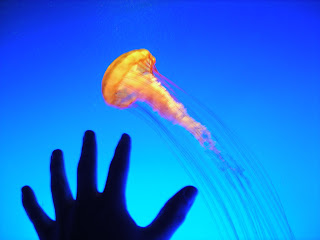
Saturday morning Pat and I saw a sight few people witness; Freshwater jellyfish in the pond at Locust Shade Park in Prince William County, Virginia. Scattered far and wide, freshwater jellyfish have been found on every continent except Antarctica and on many oceanic islands including Guam and New Zealand. They are not particularly rare, but like the pookah in Harvey, they "appear here and there, now and then, to this one and that one (and how are you Mr. Wilson?)". Freshwater jellyfish may show up in a pond one year and not be seen again for the next twenty, if ever, although they have been reported from the pond at Locust Shade for the past three years. A big reason that few people see them is that almost nobody looks. Freshwater jellyfish are not very high on the average person's list of things to see. Craspedacusta sowerbii, although not a true jellyfish, is close enough so as to make no difference; a few slight anatomical differences put freshwater jellyfish in the same group as hydras (tiny stalked critters resembling miniature sea anemones). However, if it walks like a duck, quacks like a duck, and swims like a duck...Actually freshwater jellyfish don't quack or walk and they don't swim like duck either, but you get the point.
These are interesting little blobs of protoplasm. They swim, like their saltwater cousins, by pulsating the bell and trailing their tentacles to pick up small plankton such as water fleas and daphnia. Stinging cells on the tentacles kill prey which the tentacles pass up to the mouth for digestion. The stinging cells on freshwater jellies are too small to penetrate human skin, so if you really wanted to, you could pick one up with impunity. Like sea nettles, fifty miles east in Chesapeake Bay, freshwater jellyfish are 90% water. They have an inside layer of cells and an outside layer of cells and in between, they contain gelatinous mesoglea (jelly) which gives them buoyancy. Since they are basically animated water, jellies are nearly clear with an X-shaped set of gonads standing out in white. The biggest ones are about the size of a quarter, with nickel-sized specimens far more common. Pat described them as "swimming edelweiss".
Freshwater jellyfish undergo alternating generations. Colonies of polyps, the stalked form, grow on the bottom, reproducing by branching off clones. The freshwater jellyfish part, or medusa, is the sexual generation, produced by the polyp under favorable conditions. The polyp clones several copies, stacked up like saucers, each of which separates off swims away. Once the medusae release eggs and sperm, they die. In winter, polyps go into a resting state, called the podocyst, which withstands cold. These resting cysts are picked up on bird feet and feathers and move from pond to pond, a few miles at a time, until freshwater jellyfish are found all over the world. Podocysts jump across oceans probably by hitching a ride long-distance migrants which can traverse whole hemispheres. Being a clone species has advantages; the same species of freshwater jellyfish is worldwide and is therefore unlikely to become rare. On the other hand, the medusa stage seldom bears fruit, since all the freshwater jellyfish in a pond are likely descended from a single podocyst and the medusae are all males or all females. Only when podocysts are from different ponds, of different sexes, and both clones manage to survive to the medusa stage, do genes get mixed.
Some researchers postulate that jellyfish represent an early "experiment" of life, unrelated to anything else. Indeed, fossils of jellyfish-like creatures show up in some of the oldest rocks with any traces of life. Called the Edicaran fauna (after some god-forsaken spot in the middle of the Australian outback), they were thought by some to show no affinities to any other known life forms although recent research seems to disprove this theory.
Jellyfish have always seemed to me to be too ethereal to be real (except when I get stung). Maybe it's the ghostly coloring and the unhurried pulsating swimming that makes them seem as if they really are not of this earth. Indeed, the late Carl Sagan, in speculating on possible life forms that could exist in the thick clouds of Jupiter, used jellyfish as a model. He never mentioned if they got there on bird feet.

1 comment:
Hee. "Freshwater jellyfish are not very high on the average person's list of things to see." I'm afraid I wouldn't know if I was seeing one. Do they breathe, or is that something that just doesn't matter to a jellyfish?
The fog comes in on little bird feet ... no, that's not quite right ...
Post a Comment